KFA2/Galax GeForce GTX 1080 Ti EXOC Review
Why you can trust Tom's Hardware
Board & Power Supply
Does the PCA look familiar? It's Nvidia's reference design, first seen on the GeForce GTX 1080 Ti Founders Edition, and completely unmodified here. The decision to use it is accompanied by certain advantages and disadvantages, but it definitely helps cut back on KFA2/Galax's costs.
GPU Power Supply
Just like Nvidia's reference design (along with the Zotac GeForce GTX 1080 Ti AMP Extreme we recently reviewed), KFA2/Galax employs uPI Semiconductor's uP9511 eight-phase synchronous buck controller. Thanks to a power-saving interface, it can operate in one of three modes: full-phase mode, auto-phase mode, and low-phase mode. This is important for distributing loads and hot-spots intelligently across the card.
Each of the eight outputs controls one LM53603 single-channel buck converter as some sort of driver. But why are all of the outputs under power if the card only uses seven phases?
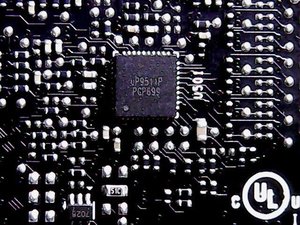
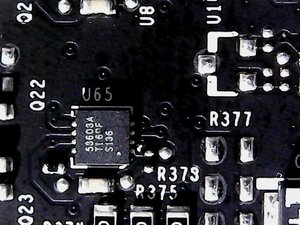
Upon closer examination, it looks like the middle phase, unlike the six others, is controlled by two VRM pairs. How is it that there can be seven phases and eight control circuits? The answer is load balancing, and this is what the card uses to ensure the motherboard's PCIe slot is never overloaded.
Let's take a closer look at the power supplied to the middle phase. It is fed via two points, and thus also comes with two separately controlled voltage converter circuits. The right one (highlighted in yellow) is supplied through the auxiliary power connector, while the one on the left (light blue) is associated with the motherboard slot. Depending on load, the middle phase can thus draw its power in varying proportions from both supply rails.
Each of the seven GPU control circuits is implemented using a pair of Alpha & Omega Semiconductor AOE6930s operating in parallel. These 30V dual asymmetric N-channel AlphaMOS components combine the high- and low-side MOSFETs. For each phase, a pair of them is used to spread the load (and hot-spots). This is, in fact, different from Nvidia's Founders Edition card, which utilizes Fairchild D424 N-channel MOSFETs.
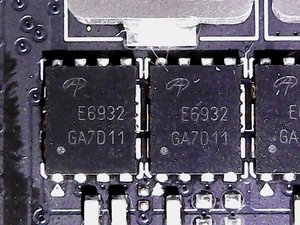
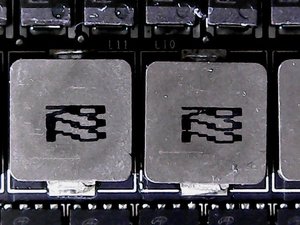
The 220nH chokes are common mass-produced components for automated assembly. They are also found on Nvidia's reference design, and are capable of handling just over 100A.
Get Tom's Hardware's best news and in-depth reviews, straight to your inbox.
Memory Power Supply
A total of 11 Micron MT58K256M321JA-110 GDDR5X ICs are organized around the GP102 processor. They're rated for 11 Gb/s, which helps compensate for the missing 32-bit memory controller compared to Titan X. We asked Micron to speculate why Nvidia didn't use the 12 Gb/s MT58K256M321JA-120 modules advertised in its datasheet, and the company mentioned they aren't widely available yet, despite appearing in its catalog. Because Nvidia sells its GPU and the memory in a bundle, KFA2/Galax has little room to innovate in this regard.
The memory gets its power via two phases, which are controlled by one uP1666 buck controller. Here as well, one LM53603 and two AOE6930s in parallel are used for each phase. Power for the memory is supplied exclusively via the motherboard slot.


Interestingly, we find more 220nH chokes instead of the commonly used 330nH alternatives.
For its BIOS, KFA2/Galax uses a Winbond W25Q40EW 4Mb serial NOR flash memory chip.


Current monitoring is handled by a triple-channel Texas Instruments INA3221. Two shunts corresponding to the 12V supply phases (motherboard slot and auxiliary power connector) determine current flow by measuring the drop in voltage.
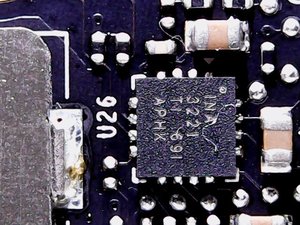

Since the PCB bears Nvidia's label, it's safe to assume the GPU vendor is responsible for the change from Fairchild D424 MOSFETs to Alpha & Omega AOE6930s. Otherwise, there weren't any other differences we identified.
MORE: Best Graphics Cards
MORE: Desktop GPU Performance Hierarchy Table
MORE: All Graphics Content

Igor Wallossek wrote a wide variety of hardware articles for Tom's Hardware, with a strong focus on technical analysis and in-depth reviews. His contributions have spanned a broad spectrum of PC components, including GPUs, CPUs, workstations, and PC builds. His insightful articles provide readers with detailed knowledge to make informed decisions in the ever-evolving tech landscape
-
sosofm A review about this 1080Ti http://www.kfa2.com/kfa2/graphics-card/hof/kfa2-geforcer-gtx-1080-ti-hof-le.htmlReply -
FormatC Reply
Just in work, stay tuned :)19861508 said:A review about this 1080Ti http://www.kfa2.com/kfa2/graphics-card/hof/kfa2-geforcer-gtx-1080-ti-hof-le.html
But in comparison with the dual-slot EVGA this solution is not worse. You can save a lot of money (and space), if you haven't such a big case. It is our job to show both sides of life - the Ferraris and the butter-and-bread cards. :)
-
Reply
You can tell just by looking at the pictures.19861700 said:Is it a blower design
Blowers have exactly 1 fan.
Blower fan blades are oriented such that the air will flow sideways.
Blowers have a casing that's designed to lead the air to the back of the card (out of the PC).
Not only does this card have 2 fans, the fan blade orientation clearly shows that the air will flow towards the card, and the casing is obviously open, which means the air isn't led anywhere.
So, no, it's not a blower design. -
Magnus Thunderson 2 HDMI 2.0 and 2 display ports would of been a much better choice but the I do not care as can not justify spending that much on a video cardReply -
photonboy Magnus Thunderson,Reply
I don't agree. I think 3xDP makes more sense. DisplayPort is becoming the standard for monitors, and people buying expensive GPU's may want a TRIPLE MONITOR setup with an HDMI left over for a BluRay playerThere are also OTHER configurations of cards for people who have different needs. -
2ndLastjedi I just got one of these GPU's, it sits at 2038 with a +136 on core @70c and can do +500 on memory but im concerned about the memory temps. Do you think the cooler solution is going to keep the memory at a safe temp with this OC?Reply


